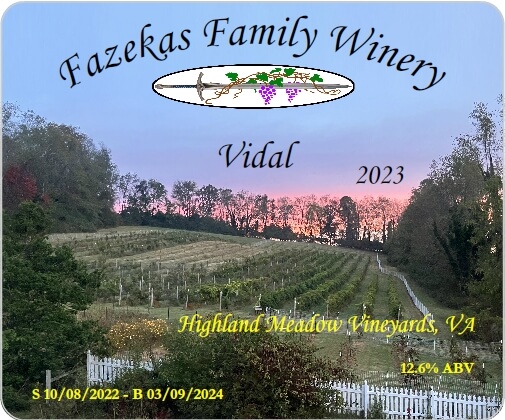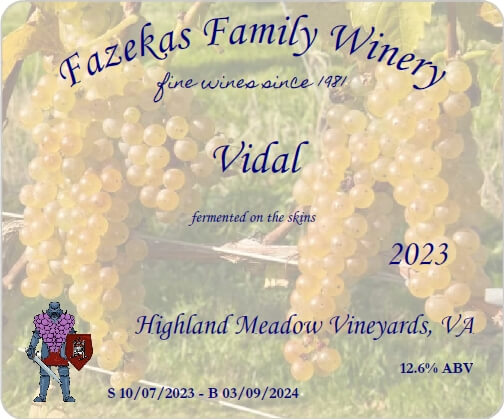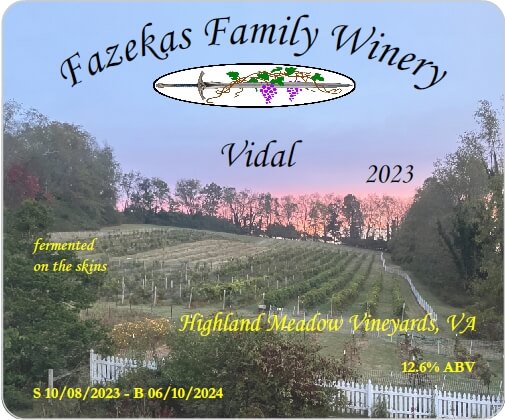2023 Vidal
October 2023
This morning I drove to a friend’s vineyard in Glade Springs VA, a 4 hour drive. She and her husband picked Chambourcin and Vidal yesterday, and we crushed 120+ pounds each of Chambourcin and Vidal for me, plus the remainder for them along with Chelois. We were done in about 1-1/2 hours.
Then I drove 4 hours home … my butt was whooped. But I had to carry the buckets downstairs, organize the batches, and make yeast starters.
Now I’m enjoying a glass of the 2022 Merlot/Tempranillo.
Like the Chambourcin, this one is an experiment. I reserved 4 gallons of juice to ferment as is typical for white wine, e.g., press the grapes and ferment the juice, which is different from red grapes where we crush, ferment, then press.
The remainder of the juice and pulp is being fermented as an “orange” wine, a white fermented on the skins like a red wine. This allows me to directly compare the two.
In March Eric & I bottled the Vidal-Juice, and as usual, made two slightly different labels. The background is Glade Springs Vineyards, where the grapes were grown.


In late April, my niece & her husband helped me bottle the first 12 liter carboy of Vidal-Orange. For this one,, the background is Vidal grapes. I only made one label this time, out of sheer laziness.

In early June I bottled the remaining 4 liters, and when I created the label I opened Eric’s Vidal-Juice as the template. Since it doesn’t matter much to me, I bottled all with his label.
It’s not as clear on screen, but for this label I faded the image slightly, as the printed label is too bright. Slightly muting the colors made a more attractive label.

Ingredients
| Fruit | 131 lbs Vidal, 4 gallons of juice is one batch, the remainder (juice and pulp) is the other |
| Maceration Enzyme | 3/4 tsp ScottZyme Cinn-Free enzyme, divided |
| Yeast | 4 tsp TR-313, in 2 batches |
| Starter | 1/2 tsp Fermax + 3 Tbsp sugar for each yeast |
| K-meta | 1/4 tsp per batch |
| Nutrient | 4 tsp Fermax per batch |
| Tannin | 1 tsp powdered grape tannin per batch |
| Sugar | 2 cups per batch |
| Fining Agent | 4 tsp bentonite |
| Glycerin | 5 oz in Vidal-Juice 9 oz in Vidal-Orange (part 1) 6 oz in Vidal-Orange (part 2) |
| Backsweetening | 3/4 cup sugar in Vidal-Orange (part 1) 1-1/4 cup sugar in Vidal-Orange (part 2) |
Method
| Crushed the grapes. Used a mesh brew bag to separate 4 gallons of juice, which is batch one. The remainder (juice + pulp) is batch two. Added 1/4 Cinn-Free to juice, 1/2 tsp to the pulp..
Made starters with 1 cup 92 F water, 2 tsp yeast, 1/2 tsp Fermax, and 3 Tbsp sugar. Didn’t bother checking brix or pH — that will be done tomorrow. |
10/07/2023 SG — |
| Tested pH, Juice 3.24 and Grapes 3.31. No changes at this time.
Initial SG for both 1.080; added 2 cups sugar to each. Added 3 tsp nutrient to each batch. Inoculated with TR-313. |
10/08/2023 Juice SG 1.088 Pulp SG 1.088 |
| Punched down 4 times yesterday. Juice has no foam, but it’s hissing from released CO2.
Added 1 tsp Fermax each at the first punch down. SG dropped rapidly. I’m considering racking juice and pressing grapes tomorrow, moving under airlock. |
10/10/2023 Juice SG 1.032 Pulp SG 1.032 |
| Juice Batch: by late afternoon the SG dropped to 1.020, so I decided to rack of the Juice and put it under airlock. My son is available to help with pressing tonight or Thursday, so I decided “tonight”.
Pulp Batch: Racked the free run wine from under the cap, grossing ~4 gallons, which went into a 19 liter carboy under airlock. The SG is 1.011, lower than the 1.018 the Juice was at when I racked it. Pressed the pomace, grossing another 4 gallons of wine. We used rice hulls again, a double handful between layers of fruit, where the layers originally started at about 6″ thick. The surprise was the SG of the pressed wine is 6 points lower than the free run. This also went into a 19 liter carboy under airlock. The wines will rest until all 3 are done fermenting. |
10/10/2023 Juice SG 1.018 Free Run SG 1.011 Pressing SG 1.005 |
| The wines are showing evidence of clearing, so I decided to add bentonite to remove any possible protein haze and to speed clearing. I did not bother checking SG.
Made a slurry of the bentonite, heating 1 cup water to 160 F and stirring in 4 tsp bentonite in a bowl. I covered it with a towel and let rest for 4 hours. During the first hour I stirred it every 10 minutes. Added 4 Tbsp slurry to each of the 3 carboys, along with a scant 1/4 tsp K-meta. Stirred well with a drill-mounted stirring rod, sweeping up the sediment. |
10/17/2023 Juice SG — Free Run SG — Pressing SG — |
| Today I racked the Vidal Juice, moving it into three 4 liter jugs and one 1.5 liter wine bottle. These went into our small fridge for a cold stabilization experiment.
The wine is still very tart — the pH measured at 3.45, although I did not calibrate the pH meter, so I’m unsure if the value is correct. The plan is to leave the wine in the fridge for 2 weeks, then rack into a 3 gallon carboy. At that time I will calibrate the meter and check pH again. |
10/20/2023 Juice SG 0.997 |
| The carboys have a lot of headspace, and while CO2 provides protection for a while, I’m leery of leaving it too long. So 1 week after adding the bentonite I racked the Orange Free Run and Orange Pressing.
The Free Run SG is 0.997 and the Pressing SG is 0.999, and after combining, the final SG is 0.998. It’s a bit higher than I expected, but not a problem I have filled a 23 liter carboy, 4 liter jug, and 375 ml bottle with wine. And another 1.5 liter bottle with sludge, that will go into the fridge. |
10/25/2023 Orange SG 0.998 |
| The Juice in the fridge is dropping acid crystals, but it’s not clearing, still very translucent. Added 1 tsp pectic enzyme to one 4 liter jug as a test. If it clears, I’ll dose the other containers. | 10/27/2023 SG — |
| Racked the Juice, filling a 12 liter carboy and one 750 ml bottle. I also have yet another 1.5 liter bottle of sludge.
pH is 3.20, lower than I expected as the initial pH was 3.24 for the Juice. The sharpness from acid is mostly gone, but this one will require either more acid reduction, backsweetening, or both. I completely forgot that I added pectic enzyme to the one jug of Juice, but noted that one seemed to drop more sediment than the other two. |
11/10/2023 Juice SG 0.995 |
| Bottled the Vidal-Juice today, that was in a 12 liter carboy plus several smaller containers. The decision was backsweeten or not backsweeten?
The previous grapefruit taste was greatly reduced, but the wine is still just a bit sharp. We added 5 oz glycerin to the bucket and 1/4 tsp K-meta. Wow! Huge difference. We netted 17 bottles. Racked the Vidal-Orange, moving the wine into three 4 liter jugs and a 12 liter carboy. The carboy received 1/4 tsp K-meta, and the jugs are in the fridge for cold stabilization. |
03/09/2024 SG 0.995 |
| Vidal-Orange (part 1): Racked the three 4 liter jugs that went into the fridge for cold stabilization on 03/09. Oddly enough, no acid crystals dropped.
Added 9 oz glycerin to reduce acid perception, which didn’t do enough, although it bumped the SG to 1.004. Backsweetened with 3/4 cup sugar. Added 1/4 tsp K-meta, 1 tsp sorbate to stabilize. |
04/25/2024 SG 1.010 |
| Vidal-Orange (part 2): Racked 12 liter carboy and extra 4 liter jug. Added 6 oz glycerin, 1/4 tsp K-meta, and 1-1/4 tsp sorbate, stirring well.
Backsweetened with 1-1/4 cups sugar, slightly more per 4 liters than than Vidal-Orange (part 1). Bottled. Had 2+ bottles worth left over, which was bottled without K-meta, sorbate, glycerin, or sugar. This will be used first. |
06/10/2024 SG 1.007 |
Notes
| Yield | 17 bottles Vidal-Juice 15 bottles Vidal-Orange, part 1 20 bottles Vidal-Orange, part 2 |
| Alcohol | 12.6 ABV |
| Residual Sugar | Vidal-Juice — 0% Vidal-Orange, part 1 — ?% Vidal-Orange, part 2 — ?% |
| 06/10/2024 | Noted again that the grapefruit flavor is strong in the unsweetened wine, but even a small amount of sugar mutes it and makes it blend in with the other flavors. |
| . | . |
| . | . |
